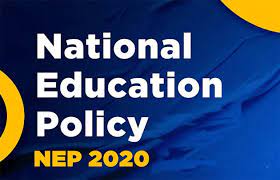By: Dr. Khalid Bashir Dar
The Four-Year Undergraduate Programme (FYUP) of the National Education Policy (NEP) 2020 in Jammu and Kashmir is a major direction in the advancement of a more flexible and varied academic environment. This curriculum promotes a learner-oriented approach by allowing students to choose their own academic paths based on their qualifications and interests. The Four-Year Undergraduate Programme supports student transition between colleges and offers a range of exit options to meet the needs of various learner types in addition to new credit systems and degree programs. This study looks at the subject selection flexibility, the FYUP’s structure, and potential implementation challenges with a focus on higher education institutions in Jammu and Kashmir’s Union Territory (UT).
NEP 2020: What it holds:
Flexibility and Multidisciplinary Approach: NEP 2020 is a learner-cantered strategy that uses a bilingual and interdisciplinary approach to offer flexibility. The idea that students should be allowed to select courses from different fields in accordance with their interests and eligibility requirements is at the heart of this system. The versatility with which credits may be earned is among the most inventive aspects. 50% of the credits that students must complete must come from the institution where they are registered, with the remaining 50% coming from other educational establishments or online resources, such as Massive Open Online Courses (MOOCs), up to a maximum of 40% of credits from these sources.
Since the creation of a Digital University, students can now earn a degree even if they do not have 50% of their credits from a single institution after meeting the prerequisite credits. Because of this unparalleled flexibility, education is now more widely available and can be adjusted to fit different learning styles.
Multiple Entry and Exit System: Multiple entry and departure points are available through the FYUP, a feature intended to accommodate students who may need to halt their study for a variety of reasons. With this approach, students can graduate with a certificate after a full year.
They are eligible to leave with a diploma after two years.
They are awarded a three-year undergraduate degree upon completion of three years.

They can pursue post-graduate or direct Ph.D. programs after completing their four year undergraduate degree if they continue into the fourth year within three years of leaving the system, students can re-enter, carrying over their earned credits and continuing their study. The maximum amount of time allowed to finish the four-year degree is seven years.
Academic Bank of Credits (ABC): Under the Digi Locker platform, the Academic Bank of Credits (ABC) has been established to facilitate the flexibility of obtaining credits from diverse universities. This approach guarantees that every credit earned has a seven-year shelf life by making it easier to store and transfer credits between platforms and organizations. In order to facilitate the smooth transfer of credits between schools and courses, students must register with ABC.
Curriculum Structure The major and minor disciplines have been added to the FYUP framework, giving students more options when choosing their courses.
Major and Minor Subjects: Pupils are required to select two fields of study: either both as majors or one as a minor and a major. From the first semester to the last, these two disciplines provide a constant, allowing students to concentrate on their areas of interest throughout the program.
If the topics are offered by the university and the student satisfies the requirements, they may switch their major and minor during their third semester of study. This flexibility won’t be available to students choosing a minor that isn’t offered as a major, either.
Pathways: The higher education institutions in the Union Territory have implemented two main routs for students to progress beyond their bachelors program, in accordance with the NEP-2020 framework:
One-Year Postgraduate (PG) Program: Students may choose to participate in a one-year postgraduate program following their completion of the Four-Year Undergraduate Program (FYUP). This reduces the length of the standard master’s program, enabling students to specialize following their extensive undergraduate education.
Direct PhD Entry: Students may choose to enroll directly into a PhD program without first completing a master’s degree if they finish the FYUP with outstanding academic status. In addition to improving academic and research output of universities, this expedites students’ entry into research fields.
Curricular Frameworks for Single and Double Majors Under the FYUP, there are two main curricular frameworks: double majorand single major. Each has different project-based learning components, internship possibilities, and credit requirements.
-Single Major: Students pursuing a single major are required to finish a certain number of credits in a variety of subject areas, including value-added courses, ability enhancement, and skill enhancement. In their last year, they must also do research projects and internships.
– Double Major: Under the double major structure, students must finish research projects, internships, and more rigorous coursework in two main areas. Though more challenging, this paradigm provides a wider range of academic experiences.

Credit and Course Breakdown An essential part of the FYUP is the credit system, which provides a flexible yet organized means of overseeing a student’s academic career. While single major and double major programs have significantly different credit requirements for the FYUP, both formats have essential elements in common. An example of the FYUP is shown in the credit distribution that follows:
Single Major Framework:
Major Subject: 62 credits
Minor Subject: 32 credits
Ability Enhancement Courses (AEC): 9 credits
Value-Added Courses (VAC): 8 credits
Skill Enhancement Courses (SEC): 12 credits
Multidisciplinary Courses: 9 credits
Internship and Research: 12 credits
Double Major Framework:
Major Subject 1: 62 credits
Major Subject 2: 62 credits
Ability Enhancement Courses (AEC): 9 credits
Value-Added Courses (VAC): 8 credits
Skill Enhancement Courses (SEC): 12 credits
Multidisciplinary Courses: 9 credits
Internship and Research: 12 credits
Particularly in the program’s latter years, both frameworks are intended to provide a balance between academic knowledge and practical skills, as well as possibilities for internships and research.
Challenges in Implementing: Although there are many advantages to the FYUP under NEP 2020, there are also some difficulties in implementing it:
Educational Disruption and Declining Enrolment J&K Colleges: The region’s political instability has historically disrupted educational development, limiting access to quality teacher training programs. Annually, over 2,000 teachers are deployed on a contract basis across Jammu and Kashmir at various colleges. In the current session, a two-month delay by the higher education department in deploying these teachers has exacerbated the issue, leaving students without educators for a significant portion of the academic year. This disruption leads to gaps in student learning and undermines the continuity of their educational process, potentially demotivating both students and teachers and further weakening the educational framework.
The above situation has prompted many students to seek admission in colleges outside the state, leading to decreased enrolment in numerous local institutions. In response, the department has issued several orders to merge students from different colleges. However, this consolidation has resulted in the discontinuation of certain subjects in various colleges, further affecting the diversity of academic offerings and weakening the educational infrastructure.
Intake Capacity: The Choice Based Credit System (CBCS) made it simpler to manage admission capacity across disciplines by requiring students to select numerous core topics. But under the NEP 2020 framework, students may only select one major and one minor, which puts a pressure on the faculty’s availability and the infrastructure, particularly given the rise in the number of students choosing a certain major mainly in city colleges.
A single major topic may require up to 20 classes per day as more students go through the semesters, requiring more classroom space and teachers. In order to prevent overstretching their resources, colleges must be aware of this problem and carefully consider their admissions policies.
Workload and Faculty Availability: Because more classes are needed for each major topic under the FYUP, it is anticipated that faculty workloads would grow dramatically. Managing 18 to 20 sections a day for a single main topic when many batches are operating simultaneouslyresults in a scarcity of staffmembers and infrastructure. Furthermore, with more courses per topic, students who choose for the research mode in the latter two semesters will put additional pressure on the faculty. In order to properly handle the workload, this additional strain could require adding more faculty members or implementing creative scheduling and teaching strategies.
The curricular framework envisions a number of ways to address these issues, includingRearrangement of Course Breakups: The University intends to reorganize the course breakdown for both single and double major topics in order to lessen the burden on faculty and infrastructure. Some theoretical classeswill be clubbed as part of this reorganization to make better use of the available space in the classroom and faculty time.
Discrepancy in Admission and Pass Percentage There was a pretty huge difference between admission rates and pass percentages in the case of 12th class. Admission rates were fixed at 45%, whereas the pass percentages were mere 36%. This deficit led to heavy concerns and immense problems as large numbers of students faced adverse effects and lost a precious year of their academic progress owing to this crisis. Although the issue was later resolved, the impact on the concerned students was still significant at least for one session.
Impact of Non-Permanent Faculty Departments with no permanent faculty members is witnessing an impressive decline in admission rates in both Jammu and Kashmir division colleges. The primary cause of the decline can be traced back to the non-presence of contractual faculty at the critical stages of the admissions process. Without experienced faculty members around who can direct and even counsel prospective students, answer their questions, and guide them, many of these departments give a feeling of instability and/or lack of support. Accordingly, the deficiency in this regard tends to adversely affect the confidence of the students toward the quality of academic activities pursued within the department and its long-term prospects; the outcome is discouragement from enrolling, leading finally to a noticeable decline in student interest and, consequently, in overall admission figures along with reputation of the department.
Frequent Changes in Syllabi Constant modifications to course curricula are confusing students. Exam papers may vary across batches, which is cause irregularities and ambiguity forstudents and teacher as well. This may impede orderly academic preparation and advancement.
Digital Divide and Technological Gaps One step in the right direction toward modernizing education is that NEP 2020 places a strong emphasis on the utilization of virtual laboratories, online courses, and digital learning tools. But J&K is beset by a digital divide, particularly in rural and isolated places where connection to the internet is either non-existent or erratic. This may significantly restrict the extent to which students in these areas may take advantage of the technology components of NEP.
Infrastructure Investment: To handle the growing number of students and courses, colleges will need to build infrastructural development in addition to classrooms and laboratories. The cost of implementing NEP 2020 throughout India, including Jammu and Kashmir, is a significant high. The plan calls for raising education spending from the current 4.6% of GDP to 6% of GDP, which is significantly a major increase. Meeting this fiscal criterion is difficult because the region is still getting over the economic hardships brought on by COVID-19. Significant financial outlays are needed for the establishment of new universities, infrastructural upgrades, and the creation of digital infrastructure for remote locations.
Capacity for Multiple Exits and Entry: Managing a student’s withdrawal and re-entry requires intricate record-keeping, particularly when it comes to monitoring their progress, grades, and credit accumulation across several platforms or institutions. This is a major burden for organizations that haven’t yet optimized their digital infrastructure or procedures.
Academic Bank of Credits (ABC): To make it easier to store and transfer credits across universities, the NEP created the Academic Bank of Credits (ABC). Unfortunately, a significant portion of students in Jammu and Kashmir and other regions of India still haven’t opened ABC accounts, which is preventing this system from being fully implemented. In many areas, the procedures for enrolling students, keeping safe electronic records, and instructing them on how to handle their credits are still in their infancy.
While NEP 2020 has the potential to revolutionize J&K’s higher education system, but in order for it to be implemented successfully, these issues need to be resolved. It will be essential to have more government backing, to invest in teacher preparation, to build digital infrastructure, and to carefully prepare for multidisciplinary education.
NEP 2020’s Four-Year Undergraduate Programme (FYUP), which places a high priority on interdisciplinary learning, credit mobility, and students independence, is an innovative and adaptable approach to higher education. Although the FYUP has many advantages—several entrance and departure points, a learner-cantered credit system, etc.—its implementation is not without its difficulties, especially when it comes to infrastructure and faculty availability.
In order to meet these challenges, institutions need to take the major initiatives to restructure their courses, invest in resources, and make sure they have the faculty and staff to fulfil the demands of the new curriculum. The FYUP exhibits the promise to completely transform higher education in Jammu and Kashmir if it is implemented correctly. It would provide students more autonomy and flexibility in determining the course of their academic careers while equipping them to meet the wide range of needs of the contemporary workforce.





